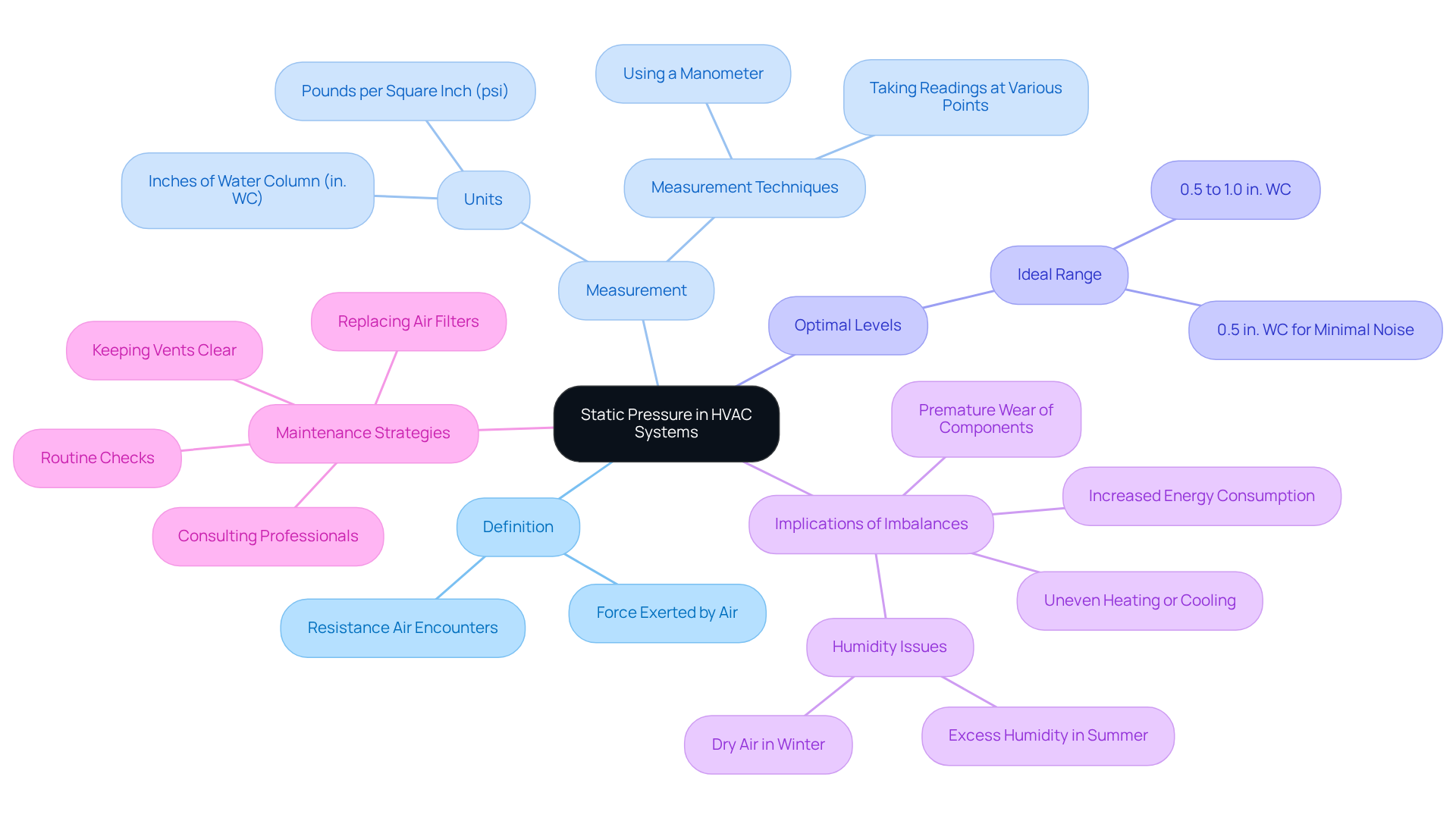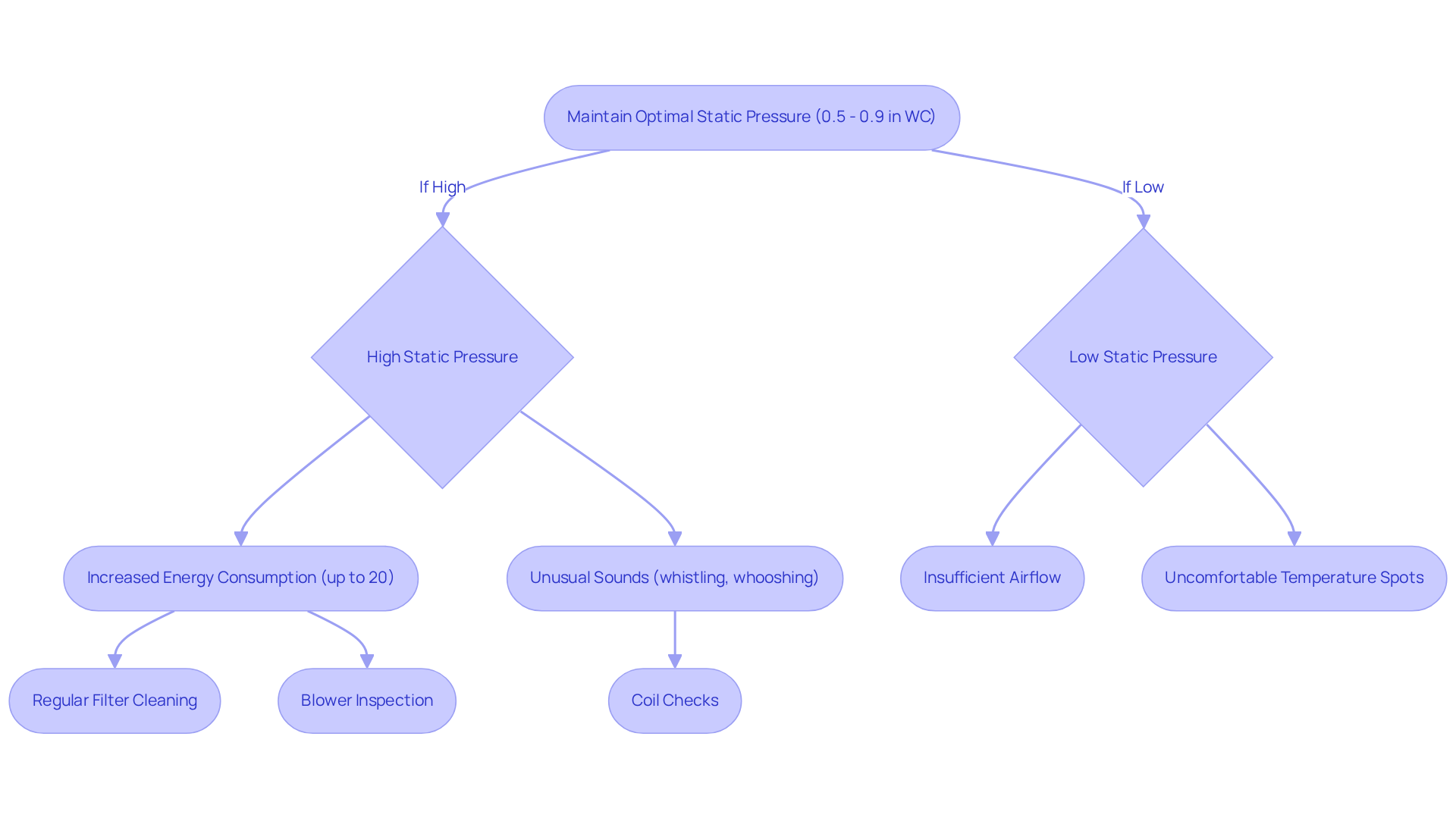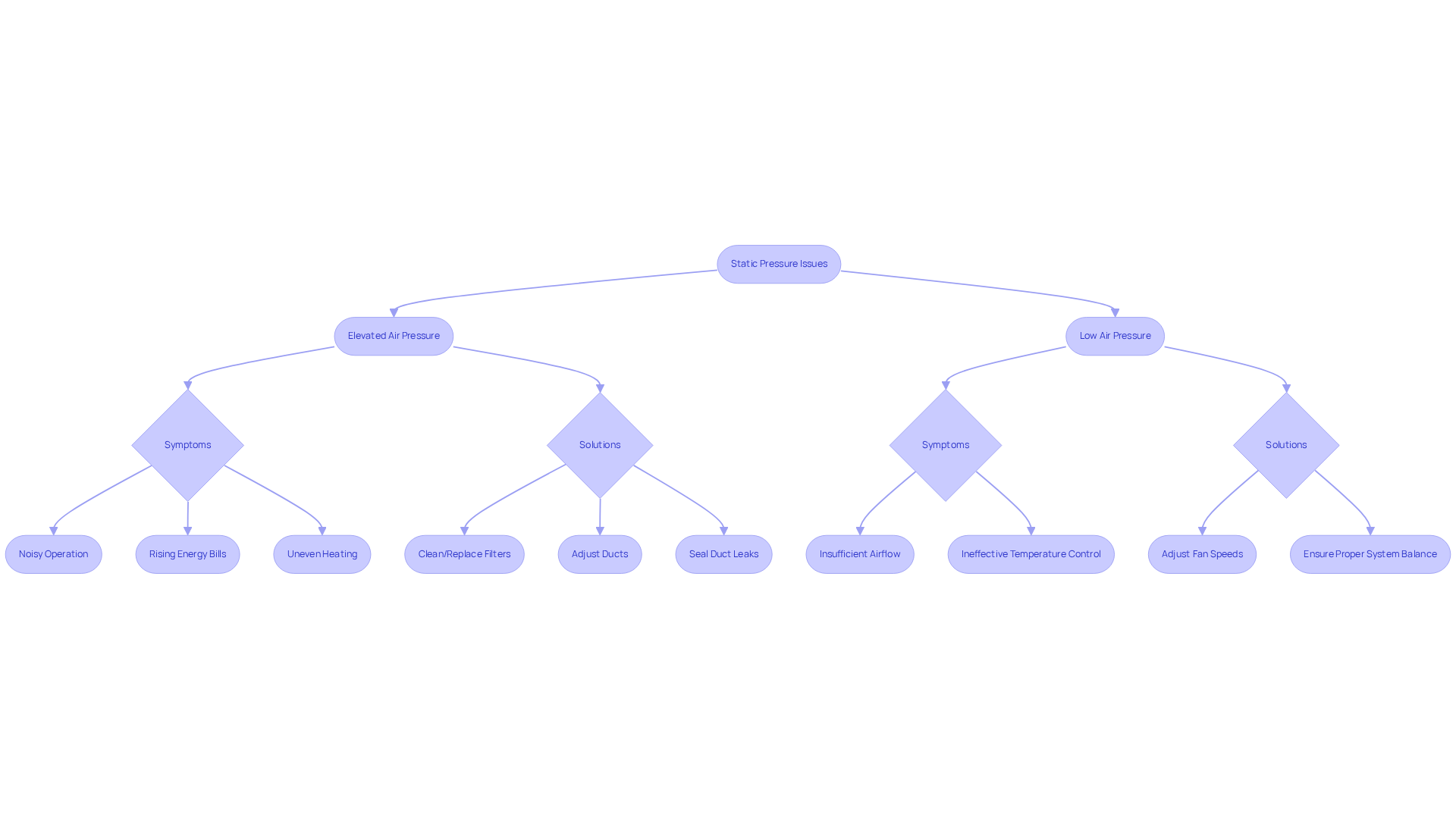Overview
Static pressure in HVAC systems represents the resistance that air encounters while moving through ductwork. This resistance significantly impacts the effective distribution of heated or cooled air throughout a building. Maintaining optimal static pressure levels is not just a technical detail; it is crucial for system efficiency. Imbalances in static pressure can lead to increased energy consumption, uneven temperature distribution, and even potential equipment damage. Therefore, understanding and managing static pressure is essential for effective climate control management.
To ensure optimal performance, HVAC professionals must regularly monitor static pressure levels. This proactive approach helps identify any discrepancies early, allowing for timely adjustments. By doing so, they can enhance energy efficiency and maintain a comfortable environment within the building. Ultimately, prioritizing static pressure management not only safeguards equipment but also contributes to significant energy savings and improved occupant comfort.
Introduction
Understanding the dynamics of static pressure in HVAC systems is essential for achieving optimal indoor comfort and energy efficiency. Static pressure significantly influences airflow and system performance, making it a critical factor in HVAC design and operation. However, when static pressure levels are out of balance, the consequences can be severe. Homeowners may face increased energy costs and uncomfortable living conditions.
This raises an important question: how can homeowners effectively manage static pressure to enhance their HVAC systems? By addressing this issue, we can explore actionable strategies that lead to improved performance and comfort.
Define Static Pressure in HVAC Systems
In HVAC setups, the definition of static pressure refers to the resistance that air encounters while moving through ductwork and other components. The definition of static pressure describes the force exerted by the air in all directions within the ducts when at rest, which is critical for the effective distribution of heated or cooled air throughout a building. Measured in inches of water column (in. WC) or pounds per square inch (psi), optimal resting levels for most residential systems typically range from 0.5 to 1.0 in. WC, with 0.5 inches being ideal for minimizing noise and ensuring proper equipment maintenance.
Maintaining the appropriate definition of static pressure is essential for ensuring that climate control units operate effectively. Imbalances can lead to issues such as uneven heating or cooling, increased energy consumption, and premature wear of components, illustrating the definition of static pressure. For instance, the definition of static pressure explains that excessive static pressure can strain fans and other mechanical parts, resulting in a noisy operation often compared to a ‘jet engine.’ As noted by Allied Air Conditioning & Heating, “If your HVAC system isn’t operating as effectively as it should, it could be due to airflow problems.”
Moreover, the definition of static pressure shows that elevated levels can cause rooms to become excessively humid in summer or overly dry in winter, adversely affecting indoor comfort and air quality. Routine maintenance and monitoring of the definition of static pressure by qualified professionals can help prevent these issues, ensuring optimal performance and comfort in indoor environments. By prioritizing static force management, homeowners can enhance their HVAC system’s efficiency and longevity.

Explain the Importance of Static Pressure for HVAC Performance
The definition of static pressure indicates its pivotal role in the performance of heating and cooling systems, as it directly impacts airflow distribution within the setup. Maintaining an optimal fixed force, which relates to the definition of static pressure ideally between 0.5 and 0.9 inches of water column (in WC), is essential for ensuring even air circulation throughout the area. This balance is crucial for consistent temperature management and overall comfort. When air resistance increases, the climate control system must work harder to push air through the ducts, leading to higher energy consumption and increased utility costs. In fact, systems operating under elevated fixed force can consume up to 20% more energy, significantly affecting operational expenses. Furthermore, excessive atmospheric force may produce unusual sounds—such as loud whistling, whooshing, or rattling—indicating stress on the equipment.
Conversely, low ambient force can lead to insufficient airflow, resulting in uncomfortable warm or cool spots within a building and negatively affecting indoor air quality. For instance, homes lacking adequate return air pathways often experience low airflow levels, which prevents the system from drawing in enough air and exacerbates temperature imbalances. Regular maintenance, including cleaning filters and inspecting the blower and coils annually—or more frequently if necessary—is vital to prevent airflow issues. By actively managing fixed force, climate control professionals can enhance efficiency, improve comfort, and extend the lifespan of the equipment, ultimately leading to reduced energy costs and better indoor conditions. Understanding and monitoring the definition of static pressure in fixed airflow is not just a technical necessity; it is a fundamental aspect of effective climate control management.

Identify Common Static Pressure Problems and Solutions
Elevated air force in heating and cooling systems can stem from several issues, including blocked filters, improperly sized ducts, and excessive bends in ductwork. Symptoms often manifest as noisy operation, rising energy bills, and uneven heating or cooling across spaces. Ideally, a well-functioning climate control system operates at around 0.5 inches of water column (in WC), with a reading below 0.9 in WC still considered optimal. Deviations from these levels can signal underlying problems.
When atmospheric force is elevated, airflow efficiency diminishes, forcing the system to work harder, which can lead to HVAC malfunctions or premature failure. Solutions for elevated resistance typically involve:
- Cleaning or replacing air filters
- Adjusting ducts to meet system requirements
- Optimizing duct configurations to minimize bends and restrictions
Additionally, maintaining appropriately sized return vents and regularly cleaning coils and filters is crucial for preventing airflow issues.
Conversely, low air resistance may arise from oversized ducts or leaks, resulting in insufficient airflow and ineffective temperature control. Addressing low airflow generally requires:
- Sealing duct leaks
- Adjusting fan speeds
- Ensuring proper system balance
Routine maintenance, including checking and cleaning coils and filters, is vital for preventing airflow problems and ensuring peak performance of heating and cooling systems.
Monitoring the definition of static pressure not only boosts energy efficiency but also prolongs the lifespan of HVAC components, reducing the likelihood of costly repairs and system failures. For instance, resolving issues like uneven heating and cooling can significantly enhance air circulation and comfort within the home.

Conclusion
Understanding static pressure is essential for homeowners aiming to optimize their HVAC systems for improved comfort and energy efficiency. Static pressure refers to the resistance air encounters as it moves through ductwork, directly influencing how effectively heated or cooled air is distributed throughout a space. Maintaining appropriate static pressure levels is crucial to avoid problems like uneven temperatures, increased energy consumption, and premature wear on HVAC components.
Key insights indicate that ideal static pressure levels typically range from 0.5 to 1.0 inches of water column. Deviations from this range can result in significant operational challenges, including noise disturbances and compromised indoor air quality. Common static pressure issues, such as blocked filters and improperly sized ducts, can be addressed through regular maintenance and adjustments to ensure optimal airflow and system balance. By proactively tackling these factors, homeowners can enhance their HVAC system’s performance, lower energy costs, and improve overall indoor comfort.
Ultimately, managing static pressure is not just a technical necessity; it is a critical component of effective climate control that offers substantial benefits for both comfort and cost-efficiency. Homeowners should prioritize static pressure management through routine maintenance and professional assessments, ensuring their HVAC systems operate at peak performance for years to come.
Frequently Asked Questions
What is static pressure in HVAC systems?
Static pressure in HVAC systems refers to the resistance that air encounters while moving through ductwork and other components. It is the force exerted by the air in all directions within the ducts when at rest.
How is static pressure measured?
Static pressure is measured in inches of water column (in. WC) or pounds per square inch (psi).
What are the optimal static pressure levels for residential HVAC systems?
The optimal resting levels for most residential systems typically range from 0.5 to 1.0 inches of water column, with 0.5 inches being ideal for minimizing noise and ensuring proper equipment maintenance.
Why is maintaining appropriate static pressure important?
Maintaining appropriate static pressure is essential for effective operation of climate control units. Imbalances can lead to uneven heating or cooling, increased energy consumption, and premature wear of components.
What issues can arise from excessive static pressure?
Excessive static pressure can strain fans and other mechanical parts, resulting in noisy operation and can lead to humidity issues in summer or dryness in winter, adversely affecting indoor comfort and air quality.
How can homeowners manage static pressure in their HVAC systems?
Homeowners can manage static pressure by ensuring routine maintenance and monitoring by qualified professionals, which helps prevent issues and ensures optimal performance and comfort in indoor environments.

